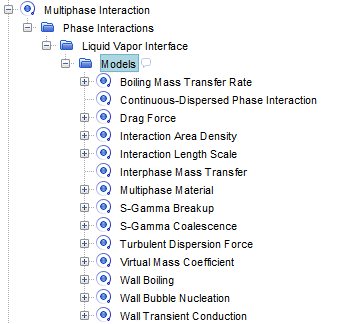Defining the Phase Interactions
Define the interactions between the phases.
Using the Multiphase Interaction model, you can define the interaction between the liquid and vapor phases.
When you create a phase interaction, you select the continuous phase first, and then the dispersed phase. When you select the dispersed phase, you also choose the phase interaction type. In this simulation, the continuous phase is Liquid, the dispersed phase is Vapor, and the phase interaction type is Continuous-Dispersed Topology.
To define the phase interactions:
- In the Physics 1 continuum, right-click the node and select .
- Rename the Phase Interaction 1 node to Liquid Vapor Interface.
-
For the
Liquid Vapor Interface phase interaction, deactivate
Auto-select recommended models, and then select the following models in order:
Group Box
Model
Enabled Models
Continuous-Dispersed Topology (selected automatically)
Drag Force (selected automatically)
Multiphase Material (selected automatically)
Interaction Length Scale
Interaction Length Scale (selected automatically)
Interaction Area Density
Interaction Area Density (selected automatically)
Optional Models
Turbulent Dispersion Force
Virtual Mass Coefficient
Virtual Mass Coefficient
Optional Models
Interphase Mass Transfer
Interphase Mass Transfer Rate
Boiling Mass Transfer Rate
Optional Models
Wall Boiling
Bubble Nucleation
Wall Bubble Nucleation
Transient Conduction
Wall Transient Conduction (Quenching)
Optional Models
S-Gamma Breakup
S-Gamma Coalescence
- Click Close.
The node is shown below:
